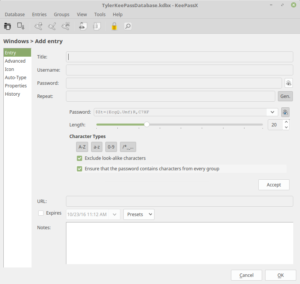
KeePassX is an independent implementation of the popular password manager that supports the KeePass (kdb) and KeePass2 (kdbx) database formats. Like the official KeePass application, KeePassX is open source but the main difference is that KeePass requires Microsoft’s .NET framework or the Mono runtime to be installed whereas KeePassX does not.
The feature list from their website shows that KeePassX offers:
- Extensive management
- title for each entry for its better identification
- possibility to determine different expiration dates
- insertion of attachments
- user-defined symbols for groups and entries
- fast entry dublication
- sorting entries in groups
- Search function
- search either in specific groups or in complete database
- Autofill (experimental)
- Database security
- access to the KeePassX database is granted either with a password, a key-file (e.g. a CD or a memory-stick) or even both.
- Automatic generation of secure passwords
- extremly customizable password generator for fast and easy creation of secure passwords
- Precaution features
- quality indicator for chosen passwords
- hiding all passwords behind asterisks
- Encryption
- either the Advanced Encryption Standard (AES) or the Twofish algorithm are used
- encryption of the database in 256 bit sized increments
- Import and export of entries
- import from PwManager (*.pwm) and KWallet (*.xml) files
- export as textfile (*.txt)
- Operating system independent
- KeePassX is cross platform, so are the databases, as well
- Free software
- KeePassX is free software, published under the terms of the General Public License, so you are not only free to use it free of charge, but also to redistribute it, to examine and/or modify it’s source code and to publish your modifications as long as you provide the same freedoms for your modified version.
I’ve been a long time user of KeePass and figured I would check out KeePassX to see if there were any advantages to making the switch. Opening up my existing KeePass2 database was a breeze and even the ‘experimental’ autofill seemed to work just fine. I should also point out that, at least on Linux, KeePassX seems to be much quicker and definitely feels more native compared to the WinForms+Mono official version (I imagine the opposite is true while running on Windows).
The password generation tool for KeePassX is also very similar to the one in the official KeePass however they’ve opted for some defaults which could actually reduce the randomness, and thus security, of a password: exclude look-alike characters, ensure that the password contains characters from every group, etc.

These defaults do make it a bit easier to read or transcribe the passwords should you ever need to and given a long enough password the impact on security should be minimal.

So what are my feelings on KeePassX overall? In my limited use it seems like an excellent alternative to the official KeePass application and one that may almost be preferred on non-Windows platforms. I think I’ll be making the switch to KeePassX for my Linux-based installs.
Update: after some slow progress a few developers decided to fork the KeePassX project over at KeePassX Reboot. We’ll have to see how things with this fork play out but I wanted to mention it here in case you decided that the fork was the better version for you.

Leave a Reply